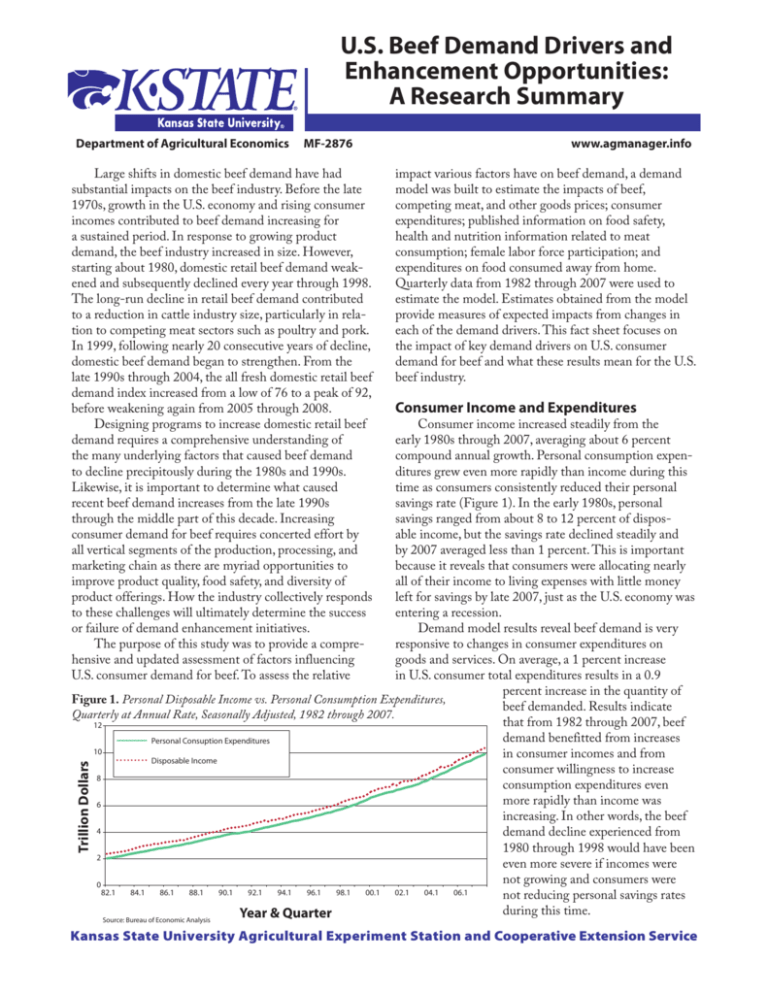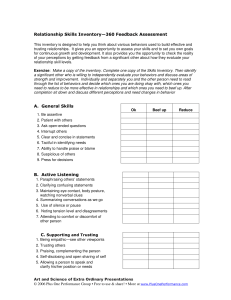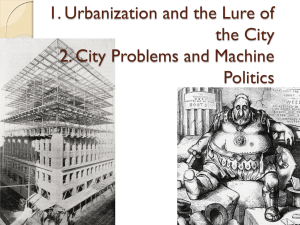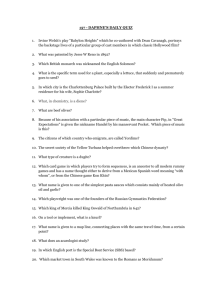
U.S. Beef Demand Drivers and
Enhancement Opportunities:
A Research Summary
Department of Agricultural Economics MF-2876
Large shifts in domestic beef demand have had
substantial impacts on the beef industry. Before the late
1970s, growth in the U.S. economy and rising consumer
incomes contributed to beef demand increasing for
a sustained period. In response to growing product
demand, the beef industry increased in size. However,
starting about 1980, domestic retail beef demand weakened and subsequently declined every year through 1998.
The long-run decline in retail beef demand contributed
to a reduction in cattle industry size, particularly in relation to competing meat sectors such as poultry and pork.
In 1999, following nearly 20 consecutive years of decline,
domestic beef demand began to strengthen. From the
late 1990s through 2004, the all fresh domestic retail beef
demand index increased from a low of 76 to a peak of 92,
before weakening again from 2005 through 2008.
Designing programs to increase domestic retail beef
demand requires a comprehensive understanding of
the many underlying factors that caused beef demand
to decline precipitously during the 1980s and 1990s.
Likewise, it is important to determine what caused
recent beef demand increases from the late 1990s
through the middle part of this decade. Increasing
consumer demand for beef requires concerted effort by
all vertical segments of the production, processing, and
marketing chain as there are myriad opportunities to
improve product quality, food safety, and diversity of
product offerings. How the industry collectively responds
to these challenges will ultimately determine the success
or failure of demand enhancement initiatives.
The purpose of this study was to provide a comprehensive and updated assessment of factors influencing
U.S. consumer demand for beef. To assess the relative
www.agmanager.info
impact various factors have on beef demand, a demand
model was built to estimate the impacts of beef,
competing meat, and other goods prices; consumer
expenditures; published information on food safety,
health and nutrition information related to meat
consumption; female labor force participation; and
expenditures on food consumed away from home.
Quarterly data from 1982 through 2007 were used to
estimate the model. Estimates obtained from the model
provide measures of expected impacts from changes in
each of the demand drivers. This fact sheet focuses on
the impact of key demand drivers on U.S. consumer
demand for beef and what these results mean for the U.S.
beef industry.
Consumer Income and Expenditures
Trillion Dollars
Consumer income increased steadily from the
early 1980s through 2007, averaging about 6 percent
compound annual growth. Personal consumption expenditures grew even more rapidly than income during this
time as consumers consistently reduced their personal
savings rate (Figure 1). In the early 1980s, personal
savings ranged from about 8 to 12 percent of disposable income, but the savings rate declined steadily and
by 2007 averaged less than 1 percent. This is important
because it reveals that consumers were allocating nearly
all of their income to living expenses with little money
left for savings by late 2007, just as the U.S. economy was
entering a recession.
Demand model results reveal beef demand is very
responsive to changes in consumer expenditures on
goods and services. On average, a 1 percent increase
in U.S. consumer total expenditures results in a 0.9
percent increase in the quantity of
Figure 1. Personal Disposable Income vs. Personal Consumption Expenditures,
beef demanded. Results indicate
Quarterly at Annual Rate, Seasonally Adjusted, 1982 through 2007.
that from 1982 through 2007, beef
12
demand benefitted from increases
Personal Consuption Expenditures
10
in consumer incomes and from
Disposable Income
consumer willingness to increase
8
consumption expenditures even
more rapidly than income was
6
increasing. In other words, the beef
4
demand decline experienced from
1980 through 1998 would have been
2
even more severe if incomes were
not growing and consumers were
0
82.1
84.1
86.1
88.1
90.1
92.1
94.1
96.1
98.1
00.1
02.1
04.1
06.1
not reducing personal savings rates
during this time.
Year & Quarter
Source: Bureau of Economic Analysis
Kansas State University Agricultural Experiment Station and Cooperative Extension Service
Looking ahead, weakness in the U.S. macroeconomic outlook for 2009 suggests that a decline in per
capita consumer income can be expected. Moreover, the
impact of weaker consumer income is expected to be
compounded by consumers’ desire to increase savings in
response to uncertainty and risk present in the financial
and real estate markets. An increase in consumer savings
means consumption expenditures will decline even
more rapidly than income and, given the importance
of consumer expenditures, a decline in U.S. retail beef
demand is likely during 2009. Longer term, it is unlikely
that domestic beef demand will rebound until the U.S.
economy strengthens and consumers regain enough
confidence to spend more of their income. Since the beef
industry can do little to dampen the industry-wide effect
of this macroeconomic demand determinant, it will be
important to focus resources in areas where noticeable
impacts are possible.
consumers want. Results from this project, in conjunction with other research, confirm that consumers want
consistently high quality beef products that are nutritious,
flavorful, tender, safe, healthy, and convenient to prepare.
Providing beef products meeting these characteristics
is challenging. Furthermore, the dynamic nature of
emerging nonprice demand determinants necessitates
regular updates regarding factors influencing beef demand
and ongoing efforts to identify and design effective
industry strategies to increase consumer demand for beef.
Food Safety
Number of Recalls/Quarter
Figure 2 documents the number of Food Safety
Inspection Service beef recalls from 1982 through 2007.
Beef food safety recalls averaged fewer than four per
quarter during this period, but ranged from a low of zero
to a peak of 15. When reviewing beef recall history, food
safety recalls have exhibited a troubling upward trend in
recent years. Not surprisingly, model results reveal food
Price Effects
safety recalls adversely impact consumer demand for beef.
U.S. consumer demand for beef is inelastic with
For example, a 10 percent increase in beef recalls is associrespect to changes in beef price. On average, from 1982
ated with a 0.2 percent decline in beef demand. However,
through 2007, a 1 percent increase in beef price resulted in
the impact of food safety recalls is most pronounced when
a 0.4 percent decline in the quantity of beef demanded by
recalls increase sharply. The recent rise in food safety
consumers. As expected, beef consumption was much less
recalls provides a good example of how food safety recalls
responsive to changes in competing meat prices than to
can negatively impact domestic beef demand. Beef food
beef prices. This means that, although price is integral to
safety recalls jumped from 18 in 2006 to 38 in 2007; this
attracting consumers to purchase beef, small price increases
rise in recalls alone contributed to a 2.6 percent drop in
or declines by themselves have small discernable impacts
retail beef demand.
on beef consumption. Beef expenditures represent a
Consumers expect food to be safe. When a food
progressively smaller proportion of total consumer expensafety recall occurs, the food safety assurance system has
ditures over time, which implies that beef demand will
failed. Responding to food safety recalls after the fact
become even less responsive to price changes in the future.
is inadequate because the damage to beef demand has
Since consumer demand for beef is inelastic with
already taken place. As the industry develops programs
respect to beef price, the beef industry should focus
designed to improve beef demand, ensuring consumers
attention on ensuring that consumers do not have
have a safe supply of beef is critical to maintaining
nonprice reasons to shift away from beef consumption.
consumer confidence. Moreover, while the analysis
One implication is that the industry should continue to
focused on domestic demand, it is also important to
strive to provide consumers with product attributes that
recognize the need for high quality, safe beef production as a necessary condition for
Figure 2. Beef Food Safety Class I & II Recalls, Quarterly, 1982 through 2007.
increasing beef exports. The beef
18
industry has devoted considerable
resources over the years to various
15
food safety initiatives. The demand
study results suggest a continuing
12
need for proactive food safety efforts
by the beef industry to avoid the
9
negative impacts associated with food
safety breaches. Because introduc6
tion of food safety hazards can occur
3
at any stage, including production,
processing, handling, and food prepa0
ration, ensuring a cooperative effort
82.1
84.1
86.1
88.1
90.1
92.1
94.1
96.1
98.1
00.1
02.1
04.1
06.1
among vertical market participants is
Year & Quarter
Source: U.S. Food Safety Inspection Service
essential.
Health and Nutrition Information
To examine the impact of consumer concerns
regarding the healthiness of eating beef, several information indices were developed and included in the
demand model. The first index focused on articles in
medical journals that contained information relating
diet and fat consumption to cholesterol, heart disease,
or arteriosclerosis. Results reveal that as the number of
articles focusing on this linkage increases, beef demand
declines and demand for nonmeat food increases. The
second index identified the number of net positive articles
(e.g., positive articles minus negative articles) published
regarding Atkins, high protein, or low carbohydrate
diets. Beef demand responded positively to the publication of information promoting Atkins, high protein, or
low carbohydrate diets. Beef demand declined when net
negative information about low carbohydrate diets was
disseminated. The third index counted the number of
articles published in medical journals regarding health
benefits associated with having zinc, iron, or protein
in diets. Both beef and poultry demand benefit from
increasing published information regarding health
benefits associated with zinc, iron, or protein in diets.
Assessing the influence of evolving public health
information on beef demand requires consideration of
both elasticity estimates and the magnitude of changes
in the respective factors. Results indicate that consumers
change consumption in response to evolving information regarding healthiness of eating beef. For instance,
the number of medical journal articles published linking
fat in the diet with cholesterol and heart disease nearly
quadrupled from 1982 through 2004 (Figure 3). Beef
demand declined about 9 percent because of this influx
of information linking fat in the diet to cholesterol and
heart disease. Similarly, the 268 percent increase in the
number of medical journal articles published noting the
importance of zinc, iron, and protein from 1982 and
2007 boosted beef demand by about 7 percent, while also
increasing poultry demand about 13 percent. Finally, the
net number of articles promoting low carbohydrate diets
increased by 245 percent from 1998 through 2003 and
then declined precipitously after 2003. The media frenzy
supporting low carbohydrate diets helped boost beef
demand by nearly 2 percent from 1998 through 2003.
However, the rapid shift from positive to negative information regarding low carbohydrate diets reduced beef
demand by approximately 0.8 percent over the four-year
period commencing with the fourth quarter of 2003.
Overall, results from the three health-related indices
confirm that consumers respond to information about
impacts on human health associated with eating beef.
For the industry, the implications are clear. First, conduct
research that helps identify positive impacts derived from
beef consumption. Second, these findings need to be
presented to health professionals, nutritionists and, especially, consumers. Furthermore, investing in the development of new production or processing technologies that
enhance beef ’s nutritional properties can be a source of
future demand improvement.
Convenience
Number of Articles
Direct measures of meat product preparation convenience at the industry level do not exist. Thus, two indirect measures, female employment outside the home and
food consumed away from home, were used in the meat
demand analysis. As the percentage of women employed
outside the home increases, it is hypothesized that time
available for in-home food preparation declines, thereby
increasing consumer demand for products that can be
prepared quickly and easily. The percentage of women
employed outside the home increased from the early
1980s when it was around 53 percent to about 60 percent
in the late 1990s, where it remained through 2007. Food
consumed away from home was viewed as a proxy for
consumer demand for convenience since consumers
often consume food away from home because it eliminates in-home meal preparation time. Food consumed
away from home increased from less than 41 percent in
the early 1980s to more than 47
Figure 3. Media Indices Linking Diet and Health, Quarterly, 1982 through 2007.
percent by 2006.
650
Model results reveal that as
600
Articles Linking Heart Disease & Diet
female
employment outside the
550
Positive Atkins Articles Minus Negative Atkins Articles
500
home and food consumed away
450
Articles Linking Zinc, Iron, Protein, & Diet
from home increases, beef demand
400
350
decreases. On average, from
300
1982 through 2007, a 1 percent
250
200
increase in female employment
150
resulted in a 0.6 percent decline
100
50
in beef quantity demanded by
0
consumers. Conversely, poultry
-50
-100
demand increased about 0.6
-150
-200
percent when female employment
82.1
84.1
86.1
88.1
90.1
92.1
94.1
96.1
98.1
00.1
02.1
04.1
06.1
increased by 1 percent. During the
Year & Quarter
Source: LexisNexis & Medline
study period, a 1 percent increase
in food consumed away from home resulted in a 1.6
percent decline in the quantity of beef demanded by
consumers, whereas pork and poultry demand benefitted
as consumers shifted toward consuming more food away
from home.
As consumer demand for products that are convenient to prepare increases, beef demand suffers, whereas
poultry and pork demand benefit. The differential impact
on beef versus competing meats demand could be related
to differences in the pace of new product introductions. For example, a search of Mintel’s Global New
Product Database from 1997 to 2008 containing the
words Convenient, Microwaveable, Ease of Use or other
time-saving claims identified 5,633 new poultry products,
but just 3,579 new beef products. To address this issue,
the industry needs additional resources devoted to new
beef product development. Product development efforts
should focus both on new beef products adapted for use
in the food service market and products well suited for
featuring in supermarkets.
Conclusions
A long-run goal of the beef industry is to increase
consumer demand for beef. To increase beef demand, it
is important to understand the key demand drivers and
then design programs that directly address those factors.
Results from a comprehensive meat demand modeling
exercise revealed that U.S. consumer demand for beef is
influenced by many traditional demand factors, including
consumer expenditures and prices for beef and competing
goods. In addition, the analysis also identified several key
James Mintert
Professor
Dept. of Agricultural Economics
Kansas State University
Cattlemen’s Beef Board
®
nonprice demand drivers that can be broadly categorized
under the umbrellas of food safety, health and nutrition,
and convenience. Consumers respond to receipt of new
information about beef including news about beef safety,
the healthiness of eating beef, or nutritional benefits of
beef consumption. U.S. consumers demand convenience
in their food products. Developing and marketing
convenient-to-prepare beef products that meet consumer
nutrition, taste, and food safety needs will pay dividends
for the beef industry.
Findings of this study also demonstrate the importance of directing industry efforts at multiple program
areas. There is no “single” dominant beef demand driver
that the industry should focus all of its attention on.
On the contrary, consumer demand for beef is jointly
determined by a number of factors. We recommend
maintaining a portfolio of beef demand enhancement
programs designed to address the key demand drivers
identified in this study. In addition, because beef demand
drivers are dynamic, on-going careful monitoring of
changes in demand determinants is essential. Finally, and
most importantly, because several integral beef demand
determinants are influenced at every vertical segment in
the beef production, processing, and marketing system,
the collective efforts of all vertical market stakeholders
throughout the industry are necessary to most effectively
increase beef demand.
For more information about this, and other agricultural
economics topics, contact the authors or visit
www.agmanager.info
Glynn Tonsor
Assistant Professor
Dept. of Ag., Food, and Resource Economics
Michigan State University
Ted Schroeder
Professor
Dept. of Agricultural Economics
Kansas State University
Acknowledgements
Thanks to the following for supporting this research:
Alabama Cattlemen’s Association
Colorado Beef Council
Georgia Beef Board
Idaho Beef Council
Iowa Beef Industry Council Mississippi Beef Council
Nebraska Beef Council
Oklahoma Beef Council
South Dakota Beef Council
Texas Beef Council
Wisconsin Beef Council
Wyoming Beef Council
Brand names appearing in this publication are for product identification purposes only. No endorsement is intended,
nor is criticism implied of similar products not mentioned.
Publications from Kansas State University are available on the World Wide Web at: www.oznet.ksu.edu
Contents of this publication may be freely reproduced for educational purposes. All other rights reserved. In each case, credit James Mintert
et al., U.S. Beef Demand Drivers and Enhancement Opportunities: A Research Summary, Kansas State University, January 2009.
Kansas State University Agricultural Experiment Station and Cooperative Extension Service
MF-2876
January 2009
K-State Research and Extension is an equal opportunity provider and employer. Issued in furtherance of Cooperative Extension Work, Acts of May 8 and June 30, 1914, as
amended. Kansas State University, County Extension Councils, Extension Districts, and United States Department of Agriculture Cooperating, Fred A. Cholick, Director.







